
Beyond the Wok
As the capital of China’s Sichuan Province,Chengdu’s richest asset is its cooking.
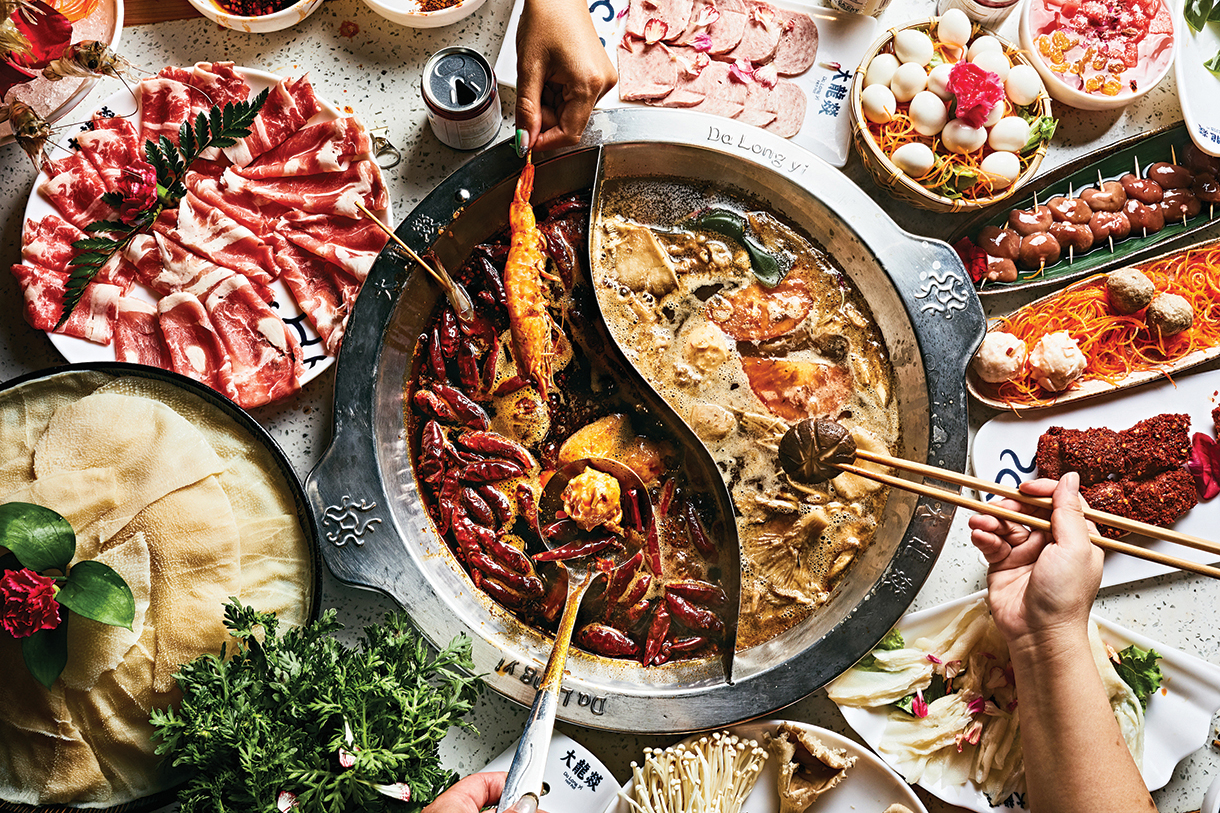
The alleyways of this street market on the northern reaches of the city of Chengdu are rimmed with sacks and drums, each filled with spices—fennel seed, star anise, or ginger. There are piles of pellets as well, which look dry and shriveled, though in fact they’re fresh-picked. Popping one like an Altoid, it tingles on the tongue with a fizzing, lemony numbness. Just in season, it’s a Sichuan peppercorn, the misleadingly named staple of the local cuisine: Rather than a relative of the chili pepper, it’s part of the citrus family.
More than just spices, the markets groan with produce, including red carrots, edamame on the vine, pea shoots, and kiwis, which the Chinese call “fuzzy monkeys.” There are trays of scarlet persimmons, earmarked for slurping messily once they reach peak ripeness. A truck laden with lotus root backs up toward a woman on her bike who holds position, angrily ringing her bell while a stall owner flares up a blowtorch and runs it deftly along the skin of a slaughtered pig to sear off the hair, right down to the trotters. The wafting smell of bacon is probably an illusion.
As a visitor, it might seem trite to spend a day strolling through a suburban market in Chengdu—after all, most tourists come here for one thing: giant pandas. Around 80 percent of the world’s remaining wild panda population lives in Sichuan province, and it’s long drawn international visitors, especially to see the baby panda–rearing program at the research center on the outskirts of town. But the food in this city is as much of a treasure as those once endangered animals.
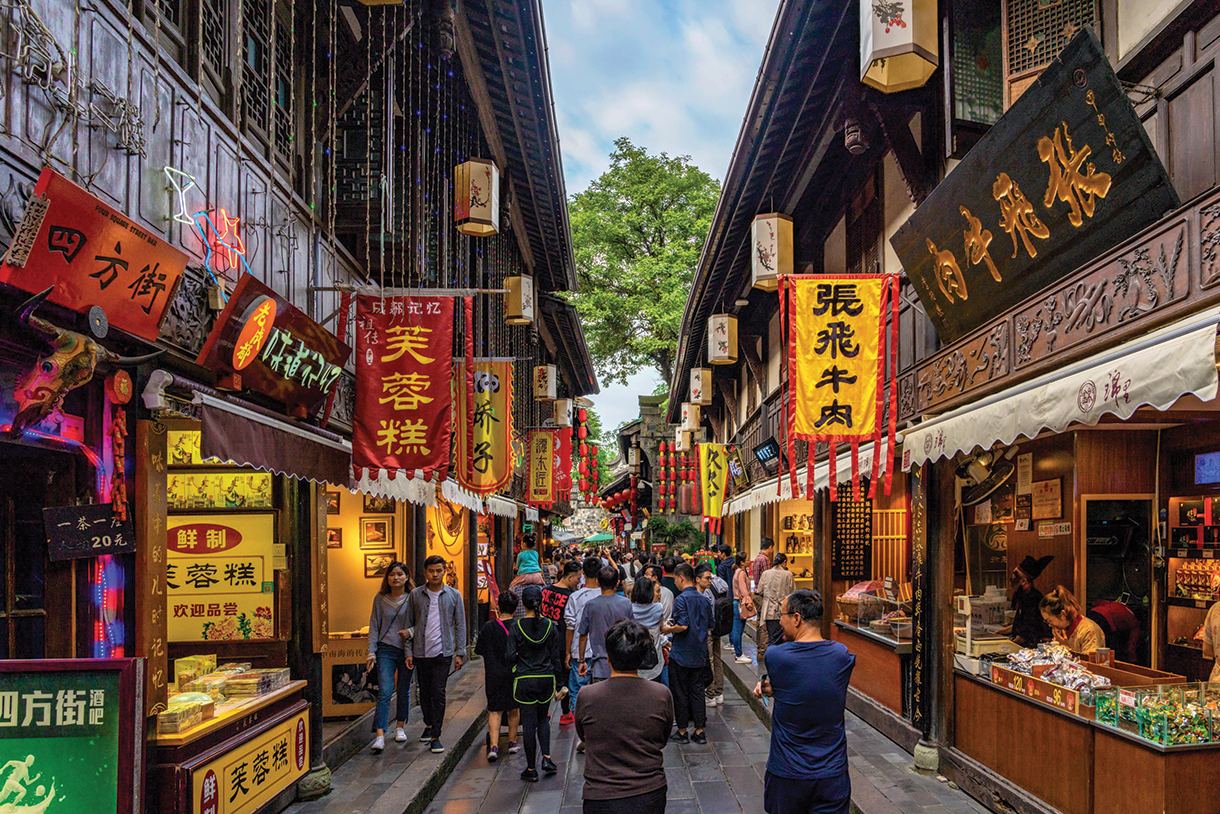
Chengdu’s Jinli Ancient Street, a traditional alleyway. Stockinasia/Alamy
Slowly, international visitors are learning what domestic tourists have long recognized: It’s worth traveling to Chengdu solely to eat. To locals, this city in China’s far west is not just the capital of the Sichuan province but also the country’s foremost gourmet destination. “Food is the only event here,” says Jordan Porter, a genial Canadian who’s lived in Chengdu for almost a decade. “Everything eventually turns into snacks—people go out for night snacks after dinner. Your whole day gets measured out in food stops.
Chengdu’s reputation among Chinese foodies—and increasingly, adventurous foreigners—is a combination of geography, history, and pride. Sichuan province, especially around Chengdu, is one of China’s most fertile areas, a low-lying basin that was irrigated early and easily. There’s a damp climate that allows almost any produce to thrive, so nothing in a suburban market was likely grown more than 20 miles away. (The homegrown food source also allowed the region to better weather the hardships and famines of Mao’s brutal regime in the 1950s and ’60s.)
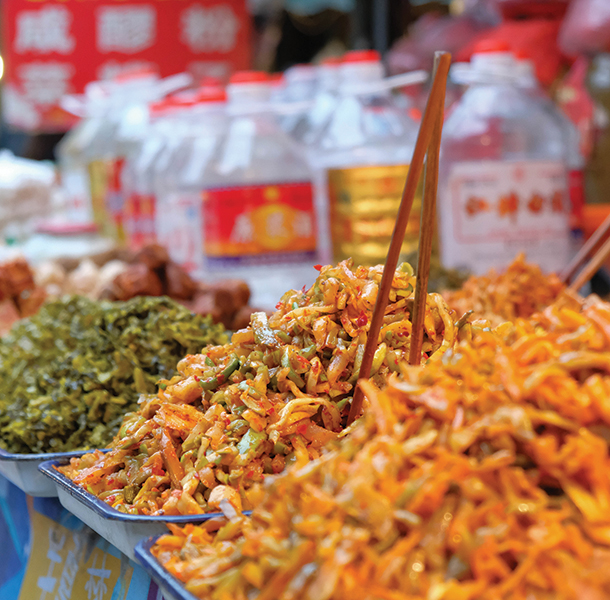
Pickled vegetables. Courtesy Chengdu Food Tours
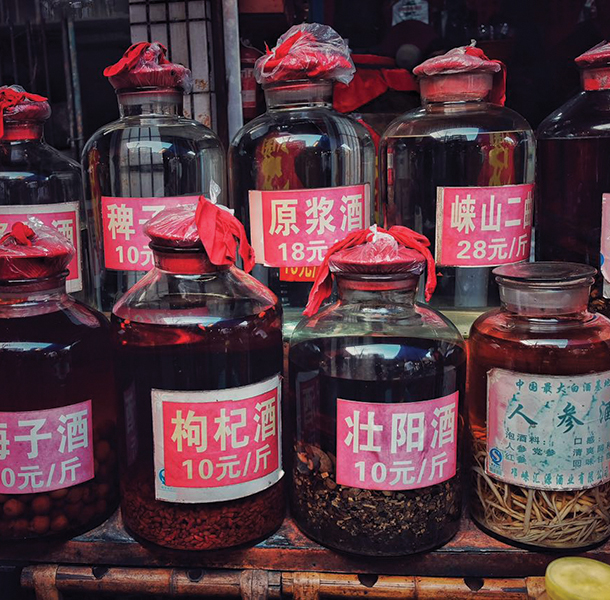
Jars of baijiu infused with fruits and herbs at a spirits vendor. Courtesy Chengdu Food Tours
During the Imperial Era, Chengdu’s location made it a nexus of the Silk Road, bringing travelers and commerce from across the world, including the spices that form the backbone of Sichuan’s fiery, complex flavors. Fennel seed is originally Mediterranean, while bay leaf and cassia come from elsewhere in Asia; chili peppers, another staple, are from Mexico.
The crucial final ingredient to its reputation for food is the local character: outward-looking and ferociously proud of its culture. “Sichuan is one of the most populated provinces in China and you can find Sichuan people across the country. As they traveled, they brought their culture of food with them,” explains Charlie Moseley, a game developer and photographer originally from Washington, D.C. “Food is important everywhere in China, but in Chengdu, it’s a religion.” Prized above all other regional delicacies, its reputation precedes it; there are few successful restaurants selling Shanghai-style xiao long bao, for example.
Shanghai exported those soup dumplings to Chinese restaurants around the world, but the cuisine from the capital of Sichuan forms the backbone of the restaurants’ menus—and with little credit. Mapo tofu, the garlicky, braised dish sprinkled with deep-fried minced meat, was first cooked up here, as was peanutty kung pao chicken, usually sprinkled with a generous handful of those tingly peppercorns. Hot pot is also a Sichuanese concept. At this fondue-like meal, diners dredge meats and vegetables in a broth at the table’s center, cooking each mouthful to order. There are restaurants that offer this stateside, of course, but they differ markedly from the hot pot joints here: The oily broth is spicier, laced with chilies and more peppercorns, and the morsels are as likely to be cow stomach or duck tongue as chunks of chicken breast.
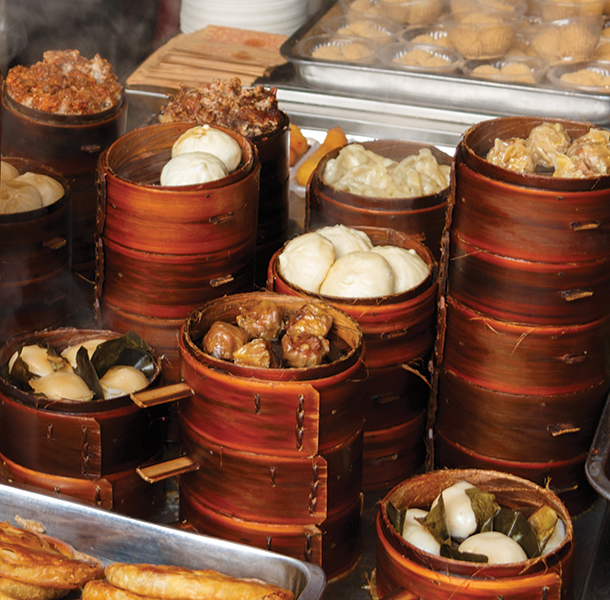
Steamed dim sum snacks. Ke Cao/Adobe
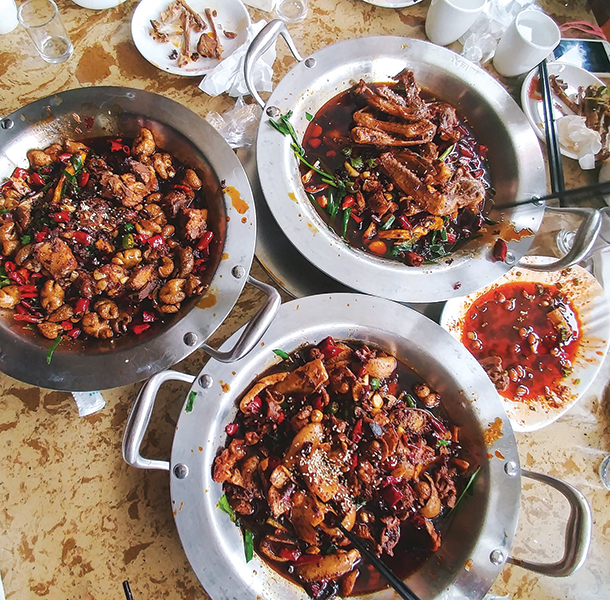
Dry pots of duck and rabbit. Courtesy Chengdu Food Tours/Anita La
Canadian expat Porter noticed Chengdu’s devotion to food when he arrived after college and greedily explored the backstreet cafés and markets, but it was only four years ago that he turned his hobby into a business called Chengdu Food Tours (chengdufoodtours.com). Porter is now the foremost guide squiring curious visitors around Chengdu’s secret foodie corners. He escorts them to markets, cafés, and restaurants with a rangy energy, hopping in and out of taxis to zigzag across the city’s crowded streets.
At one market, he pulls up in front of a stall lined with enamel trays holding brightly colored ribbons and strange, furry cubes. He picks up one of the latter and breathes in the funky aroma. Though it smells and tastes much like a ripe blue cheese, this is tofu, fermented with bacteria and doused in chili and salt. Another stall is selling douban sauce, the chili and fava bean paste that provides much of Chendunese cooking with its delicious umami kick, whether added to hot pot or used when braising mapo tofu.
Porter has particular expertise in baijiu, which has a long history here. One of the country’s foremost distilleries, Shui
Jing Fang, still operates downtown. He is determined to help the Chinese liquor reclaim its unfair reputation as hooch-like firewater. He stops at a stand full of giant earthenware jars, their mouths covered in scarlet cloth. The stall owner grabs an empty old bottle of Poland Spring, sluices it clean with neat alcohol, and dredges in the murky liquid. Aromatic and soft on the palate, it’s a revelation. “Baijiu should always be paired with food,” Porter says, slightly apologetically. “So, I often run private, custom tours and events, where we incorporate baijiu into tastings at different spots.”
The restaurants where he chooses to do this are unlikely, at least at first glance. Take the guo kui store (more like a closet than a café) where a few older ladies work ferociously, warming a pita-like bread on a tandoor oven–style lid before stuffing the pouch with shredded beef and crunchy bamboo. A garlicky cross between a falafel and a sloppy joe, the moreish delight costs around 70 cents; paper money is dropped into a dish so no cooks’ hands touch it.
“She started out, this grandma, with a cart, but there are laws against that now,” Porter says, nodding and smiling with one of the women. “Now she doesn’t franchise, but you can stage with her and then open a shop selling these, as long as you don’t do it in Chengdu.” The bowl of sweet-water noodles at another so-called fly restaurant (because of the buzz as people rapidly come and go) arrives in less than a minute. Cool and chewy, smothered in a chili sauce and sprinkled with sugar, they’re the perfect balance between savory and sweet. Chengdunese food, while gourmet, has a refreshingly homestyle edge with an unfussy focus on ingredients.
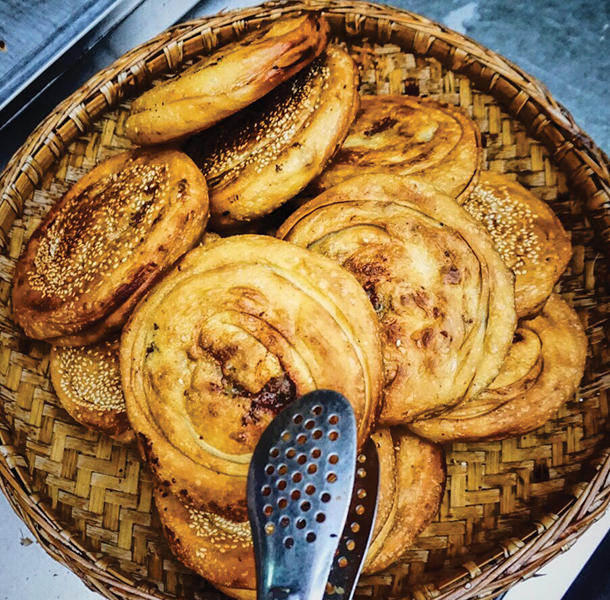
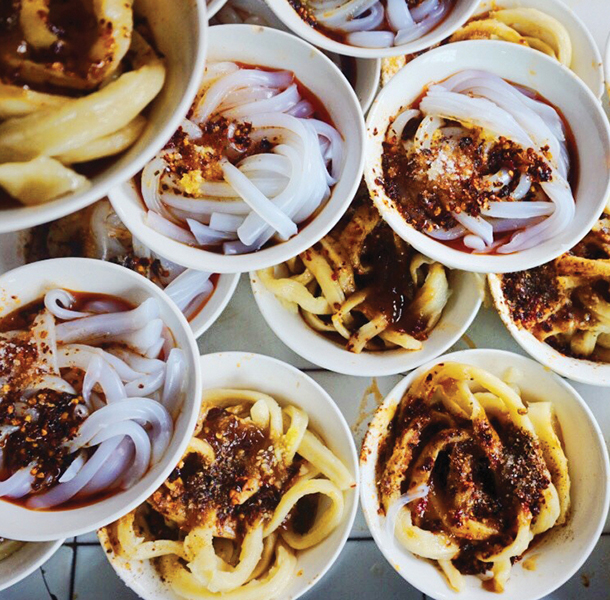

No wonder that even the city’s finest dining spots are unassuming. The most popular conceit is a private kitchen. Diners are essentially visiting a chef at home, where he or she will cook a meal for them, as if their guest. Gui Mian is typical of this idea, set on a quiet side street with little indication that it differs from the houses around it. When a waitress spots a confused visitor pacing the street, she dashes outside to welcome them in. The small front room has little atmosphere—the lights are neon-bright and there’s no music—but the 18-course meal is extraordinary. Each dish is a few mouthfuls: a single vegetable dumpling, for instance, or a piece of chicken, tender enough to melt in the mouth, sitting in gleaming, rich broth. A palate-cleansing tofu with peanuts and peppercorn oil tingles on the lips, and inside a hot and sour soup floats a small, firm-fleshed sea cucumber.
But that isn’t the most unusual ingredient Porter showcases. Rabbit is another staple of Sichuanese cuisine, and many of the snack stands dotted around the market feature racks of them, spit-roasted and crispy; the meat is pulled off in chunks, doused in chili and sesame oil, and eaten from an aluminum pouch like warm, fresh jerky. Only one part is reserved: the head, which sits in a heated case, staring out silently, and Porter orders one to try. It tastes gamey, though it’s hard to find the meat, the tongue searching each crevice. That rabbit head snack is the embodiment of Chengdunese cuisine: simple, unexpected, and packed with flavor. “Food is a game of flavor, not just sustenance,” Porter swoons. “The meal is the party—you want to extend it, slow it down, hang out with all of the flavor, and interact with it—almost like having a conversation.”

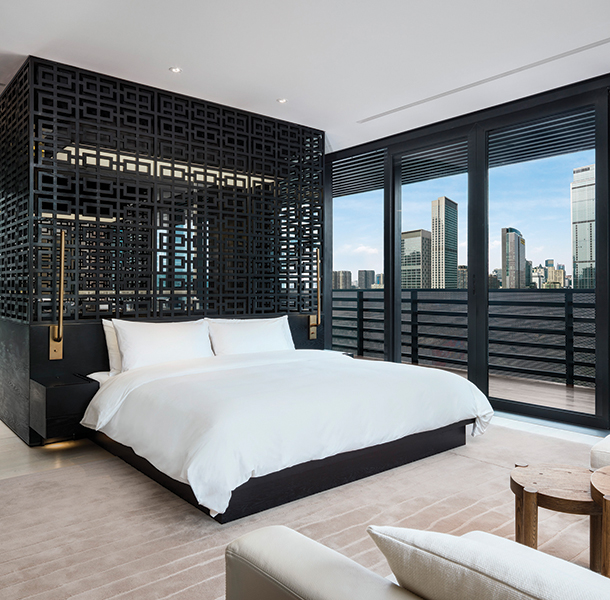
Go and Stay
Hainan Airlines (hainanairlines.com), the high-end, China-based carrier, provides several nonstop routes to Chengdu from major American gateways, including LAX and JFK.
The best place to stay is The Temple House complex (from $270, thetemplehousehotel.com), a luxury hotel that sits in the heart of the city and includes a converted temple on its grounds, now used as a spa and restaurant.




